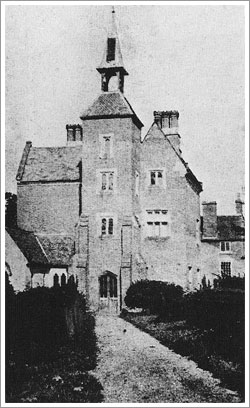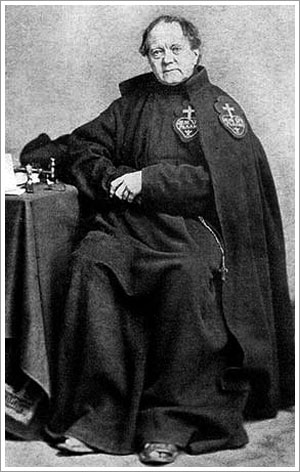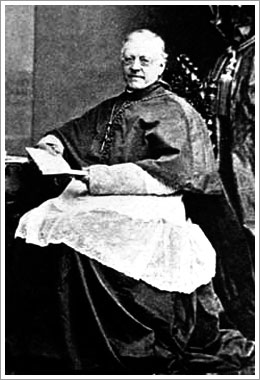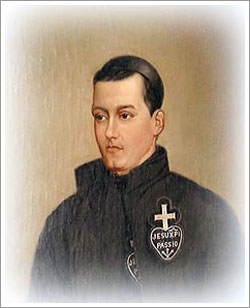On the first stage of his journey Charles was accompanied by one of the community of Holy Cross Retreat; Fr Turrenius, an Italian Passionist who had worked in England before coming to Ere travelled with him as far as Dover. In a letter written to his family on 2 March 1852 Charles describes what happened after he left Belgium:
My journey from Belgium to England went very well. A priest from Belgium accompanied me as far as Dover and after this I travelled alone, for the most part by train. At times I travelled along under the ground and so I found myself in complete darkness. Everything went quite well during the sailing; I did, in fact, feel a little uncomfortable, but the fact that it was raining and was quite windy has to be taken into account, and soon after the crossing I recovered completely. We have a monastery near London and I stayed there for two days. From there I left for Aston Hall, staying five days in that house. I then headed for St Wilfrid’s with our Rev Fr Provincial, and it is in this beautiful monastery that I am to stay. I have already grown used to the English climate and am beginning to speak a little English; pray for me that I learn to speak the language like a true Englishman, and pray also for the poor Protestants of England that one day they will be converted to the true faith. I pray often for you all.
The monastery near London in which Charles stayed for two days was at Kilburn. This house, known as the Hyde, in Cool Oak Lane (otherwise known as Wood Lane), was the London home of the Passionists before the opening of St Joseph’s Retreat, Highgate. St Michael’s Retreat, Aston Hall, where Charles spent five days after leaving the Hyde, was near the town of Stone in Staffordshire. Founded by Blessed Dominic Barberi ten years earlier, it was the first Passionist house in England. Charles’ final destination, St Wilfrid’s Retreat, Cotton Hall, was also in Staffordshire, but further north, near Cheadle.
 After his conversion to Catholicism in 1845, Frederick William Faber had founded a religious community which he called the Company of the Will of God. Lord Shrewsbury, a Catholic, gave Faber a house across the valley from his own home, Alton Towers. This house, Cotton Hall, became the home of Faber’s community who during their short lifespan were also known as the Wilfridians. When in 1848 Newman returned from Rome to introduce the Oratorians, Faber, who was then thirty-four, decided that the will of God was that he and his companions should transfer to the Oratory. St Wilfrid’s was offered by Faber to the Passionists, who made it their House of Studies. right: St Wilfrid’s Retreat
After his conversion to Catholicism in 1845, Frederick William Faber had founded a religious community which he called the Company of the Will of God. Lord Shrewsbury, a Catholic, gave Faber a house across the valley from his own home, Alton Towers. This house, Cotton Hall, became the home of Faber’s community who during their short lifespan were also known as the Wilfridians. When in 1848 Newman returned from Rome to introduce the Oratorians, Faber, who was then thirty-four, decided that the will of God was that he and his companions should transfer to the Oratory. St Wilfrid’s was offered by Faber to the Passionists, who made it their House of Studies. right: St Wilfrid’s Retreat
In bringing Charles to St Wilfrid’s the Provincial hoped that he would have a better opportunity of learning English well. At that time many of the priests in the English Passionist monasteries were Italian; here at St Wilfrid’s, living with the English and Irish students, Charles could begin to speak a little English.
About a month after Charles’ arrival the community were visited by Fr Ignatius Spencer. A former Anglican clergyman and son of Lord Spencer, Fr Ignatius had been the first non-Italian Passionist to hold the office of Provincial, having been nominated by Blessed Dominic as his successor. Dominic had held Ignatius in the highest esteem and had written of him to Fr Pius Cayro, one of his former students, ‘If you could only see what a splendid man he is! What zeal, what ardour for the glory of God! He seems like a new Saint Paul.’
Fr Ignatius already knew Charles from Belgium, and he had also been introduced to his brother Peter Joseph when he visited the seminary to ask for prayers for England. In fact, he had met the other members of Charles’ family, including his father, when on 28 August 1849 he had visited Munstergeleen with Brother Anthony Raaymakers. For Charles’ family this may have been the first opportunity of seeing the Passionist habit, as we learn from a letter Ignatius wrote a week after leaving Munstergeleen, in which he describes how he was travelling:
I came first to Ere and started on my journey from thence, being joined by one of the lay brothers from that house, called Brother Anthony, a Dutchman, at Brussells, and with him I am travelling thro’ Holland in our habits more in the style of monks that I have found myself before but this does not mean much discomfort.
 Ignatius, who could speak French, Italian and German, had started learning Dutch two years before his visit to Munstergeleen and so would have been able to converse with Charles’ family. Meeting Charles again in Cotton hall, he would have been able to note how he was settling into life in his new home. In a letter written to the Provincial, Fr Eugene, on 24 April 1852, a week after his visit to St Wilfrid’s, Ignatius, who was then First Provincial Consultor, gives evidence of the good impression Charles made on him and refers to him as someone who could be relied upon to maintain and sense of order and act responsibly. right: Ignatius Spencer, C.P.
Ignatius, who could speak French, Italian and German, had started learning Dutch two years before his visit to Munstergeleen and so would have been able to converse with Charles’ family. Meeting Charles again in Cotton hall, he would have been able to note how he was settling into life in his new home. In a letter written to the Provincial, Fr Eugene, on 24 April 1852, a week after his visit to St Wilfrid’s, Ignatius, who was then First Provincial Consultor, gives evidence of the good impression Charles made on him and refers to him as someone who could be relied upon to maintain and sense of order and act responsibly. right: Ignatius Spencer, C.P.
In June 1852 a new student arrived at St Wilfrid’s from the novitiate. His name was Paul Mary Pakenham. A son of the Earl of Longford and nephew of the Duke of Wellington, he had been a Catholic for only two years. He was three months older than Charles and had been a captain in the Grenadier Guards before becoming a Passionist. Born in Dublin, it was he who would be chosen four years later as superior of the first Passionist house in Ireland, Mount Argus. No doubt these two young men, both ex-soldiers but from different armies and with very different backgrounds, felt drawn to each other by the generous spirit which each recognised in the other. As they talked to each other in the gardens of Cotton Hall, Paul Mary helping Charles with his English lessons, little did they think that one day both their names would be linked with an Irish monastery, founded by one and sanctified by the other.
A year after his arrival in England, Charles was transferred to St Michael’s Retreat, Aston Hall, arriving there on 5 February. There were six others in the community: three priests, all of whom were Italian, and three brothers, of whom two were Dutch and one, Brother Michael Behan, Irish. Brother Michael was to spend many years with Charles, first in England and later in Ireland.
Unlike St Wilfrid’s, where there were few Catholics, St Michael’s Parish was growing rapidly. Located in an area which was more industrial than rural, it had become home for many of the Irish immigrants who had poured into England as a result of the famine of 1846. Assigned to work in the parish, Charles found himself ministering often to people who were exiles, as he was. He felt drawn to the ‘poor Irish’ who seemed to him very like his own people. At the same time he did not forget that he had been sent to work for the people of England, as can be seen from a letter he wrote to his family on 16 September 1853 in which he says,
Pray for the Protestants of England and Holland, that God may grant them the grace of a sincere conversion. Our blessed founder, Father Paul of the Cross, prayed for fifty years for the conversion of England.
Charles’ first experience of parish work lasted less than two years. On 13 October 1854 the novitiate was transferred from St Saviour’s Retreat, Broadway, Worcestershire to St Wilfrid’s, Cotton Hall, and about a month later Charles was sent to St Wilfrid’s as assistant to the Novice Master, Fr Salvian Nardocci.
Fr Salvian was a remarkable man in many ways. A great lover of order, he held the office of Master of Novices for many years. In every house in which he lived we find him making a catalogue of the books in the library, arranging the music in the church, repairing the vestments and tidying the sacristy, finding a place for everything and putting everything in its place. He drew up the liturgical calendar for the Province each year. Any references to the Passionists in the newspapers he would cut out and paste into his book of cuttings. He had a great sense of history and was a compulsive writer, not of letters but of what we might as a general term call ‘memories’: biographies, historical records and, most important for our purposes, a diary. This diary, covering a period of about thirty years, is one of our most valuable sources of information about Charles.
Not many months after his arrival at St Wilfrid’s, Fr Salvian was given other duties which kept him away from the novitiate for quite a while. In one of the neighbouring parishes, about seven miles from Cotton Hall, lived a parish priest who quite literally thought he owned the church. This man was under the mistaken impression that the late Earl of Shrewsbury, who had built the church and presbytery, had left both buildings to him in his will. Consequently, when  Bishop Ullathorne tried to transfer him to another parish, he refused to go, saying, according to Salvian, that no one, not even the Bishop, could remove him from that place. The Bishop, wishing to avoid any publicity, sent the Vicar General to visit him, to try to settle the matter quietly. Salvian tells us that the Vicar General tried everything to induce the Priest to obey the Bishop, but all in vain. Seeing that he was making no progress,
Bishop Ullathorne tried to transfer him to another parish, he refused to go, saying, according to Salvian, that no one, not even the Bishop, could remove him from that place. The Bishop, wishing to avoid any publicity, sent the Vicar General to visit him, to try to settle the matter quietly. Salvian tells us that the Vicar General tried everything to induce the Priest to obey the Bishop, but all in vain. Seeing that he was making no progress,
he went into the Sexton’s house, to ask for the key of the church, which was kept by him. The Parish Priest followed a few minutes after, and entering the house, without much ceremony, took the poor Vicar General by the collar and thrust him out of the house, into the pubic street. Several people saw the poor Vicar General treated by the priest as above. In a few minutes the whole village came to know about what had happened, and it naturally gave great scandal. As son as the Vicar General had freed himself from the grasp of the Parish Priest, there and then, in the public street and in the present of several people who happened to be there, he suspended him as he justly deserved.
The next day Bishop Ullathorne wrote to St Wilfrid’s, asking the superior to appoint a priest to look after the parish in question until the situation could be resolved. Fr Salvian was sent and over a long period of time succeeded not only in caring for the parish but also in reconciling the parish priest and his Bishop. Salvian was fortunate in having Charles as Vice Master at this time, as it meant he could be away from St Wilfrid’s without anxiety, as he himself realised when he wrote: ‘As Fr Charles took great care of the novices, I let him have the whole care of them, except that I heard their confessions, and conferences.’ above: William Bernard Ullathorne O.S.B., Bishop of Birmingham
In the Central Archives of the Passionist in England is a book on the front of which is written Book of the General Administration of St Wilfrid’s Retreat; it is a book which tells a sad story in a few words:
February 1855. From the accounts made with Father Vicar results that remains in hand from last month seven shillings.
March 1855. In Father Vicar’s hand nothing.
April 1855. In Father Vicar’s hand one pound, three shillings and ninepence.
May 1855. We find that Father Vicar has spent the money which was in his hands.
June 1855. Father Vicar has spent all the money which was in his hands.
Although the parish attached to St Wilfrid’s was ‘immensely large in extent of territory’, there were only a handful of Catholics and these were not able to provide for the needs of the religious community and its novices. The late Earl had wanted a monastery near at hand and had been a generous support to the community but his successor, who was not a Catholic, could hardly be expected to show the same interest. Fr Salvian explains the situation and its outcome:
During the summer St Wilfrid’s was something like a terrestrial paradise, but in winter the cold and damp were insupportable. We were very poor, and had no means to keep up fires in our rooms.... Novices also were not coming, and those few who came, besides not having brought anything, finding the place too cold and damp in winter, left us one after the other, except one. There was no alternative but to starve or leave the place. We decided on the latter.
On 8 November 1855 Fr Salvian returned to Broadway, taking with him his one remaining novice. Most of the other members of the community also went to their new homes. Charles and another priest, Fr Raymond Disano, stayed on at St Wilfrid’s until a diocesan priest would be sent to care for the parish. Although his parishioners were scattered over a wide area and his appointment only a temporary one, Charles set about visiting the homes of the people which his usual determination. However, three months later the new parish priest arrived and the two Passionists moved on, Fr Raymond to Broadway and Charles to St Anne’s Retreat, Sutton.
 It would be difficult to imagine two more different settings for a monastery than Cotton and Sutton, the first situated in a remote corner of the English countryside, the other in the busy Lancashire town of St Helens. Describing the monastery to which he had just been sent, Charles writes, in a letter to his uncle:
It would be difficult to imagine two more different settings for a monastery than Cotton and Sutton, the first situated in a remote corner of the English countryside, the other in the busy Lancashire town of St Helens. Describing the monastery to which he had just been sent, Charles writes, in a letter to his uncle:
It is beside the railway, and there are lots of factories nearby, including a fine, big glassworks. We are not far from the cities of Manchester and Liverpool.
Charles was there for only a few months, but this was just his introduction to Sutton; he would return later and would spend five years working as a curate in St Anne’s Parish.
On 25 June he was transferred to London. What he did there we cannot say; no mention of him is made in any of the records of the London community from that time. Four weeks after Charles’ arrival at the Hyde, Fr Paul Mary Pakenham came to London from Rome. He was on his way to Dublin where he was to be the first Rector of the new foundation at Mount Argus. No doubt he and Charles were delighted to see one another again. They did not realise that they would never meet again; within twelve months Charles would be transferred to Dublin, but Paul Mary would be dead. above, right: Paul Mary Pakenham C.P.
top of page
© Paul Francis Spencer, C.P. 2007 - 2020 - all rights reserved
This biography, paper-published in 1988 at the time of Father Charles’ beatification, was how I became acquainted with the life of Father Charles. Although you will find the entire text at this site, I encourage you to look for the new paper edition of the book, which will be available in bookshops in mid-2007.

